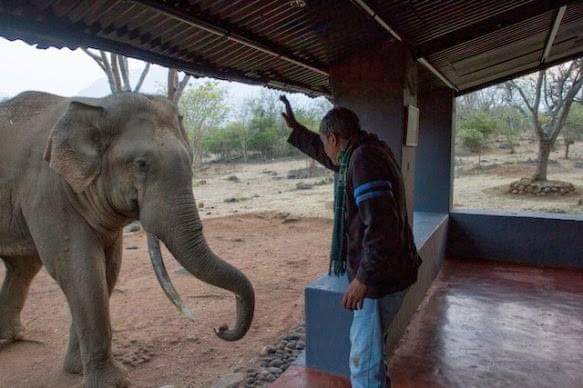
Looking for Mark: Dead friend’s memory draws a Nilgiri tusker to 'Cheetal Walk'

The release of elephant Rivaldo back to the wildness of The Nilgiris, after three months in captivity, has been a cause of revelry among forest officials and conservationists alike as it was the first time a tusker kept in captivity was set free into the forest. But certain challenges still remain. The foremost is the hiccups that officials still face in preventing Rivaldo from entering human habitation – the reason he was taken into captivity in the first place.
While it is suspected that Rivaldo comes back to human habitation in search of his human friend Mark Davidar, conservationists say his visits could be phased out if locals stopped feeding him and other elephants food, often done in a gesture of affection.
An article published in Frontline in 2011 claims that elephants have been frequenting the area surrounding ‘Cheetal Walk’ (a forest shelter located in the fringes of Mudumalai Tiger Reserve, owned by marine biologist Mark Davidar, son of renowned wildlife conservationist ERC Davidar) and have got accustomed to the presence of humans there since the 1980s. Rivaldo, who was found in Sigur plateau in the Nilgiris district, was one of them. He reportedly is being fed by locals since 2008.
His frequent brush with human habitation, however, cost him dear. In 2013, Rivaldo lost 30 cm of his trunk. The story of how he lost his trunk has two versions though: The first one says the tusker could have been injured while begging for food on the streets while the second one says he was caught in a snare set by hunters to kill wild boars.
L’affaire Mark
It was Mark Davidar who took care of Rivaldo when he was injured and gave him food and medication. After his trunk healed, Mark stopped feeding Rivaldo to wean him off food provisioning and encourage him to shift to coarse vegetation. Rivaldo would visit the premises where he underwent treatment and wait to be fed, sometimes for hours.
“When no food came, he would leave. His visits became sporadic and shorter. After six months, he would stop by for a few minutes and then leave,” records well-known conservation biologist Priya Davidar, daughter of ERC Davidar, a renowned wildlife conservationist, in the recent issue of the journal Trumpet.
Mark settled in Cheetal Walk – established in 1967 – after a stint with the Bombay Natural History Society and the Madras Snake Park. The house is located near Sigur corridor, one of the important corridors in Nilgiri Biosphere Reserve.
Mark’s house was a usual haunt of the tuskers and the biologist ended befriending many of them including Rivaldo as well as two others named Ronaldo and Roberto.
Mark said in the Frontline article that Rivaldo “is intelligent, but gets violent unnecessarily. Yet he is a peace-loving animal.”
A nature lover, Mark died in 2013 due to some health issues. However, many locals say that he was injured and died after an elephant chased him.
Priya, however, rubbishes the claim.
After Mark’s death Rivaldo was again injured in 2015 by a wild tusker.
“Again he was treated at the same place without restraint, and the same pattern of violation was recorded after the feeding was stopped,” Priya says in her article.
It was after his second injury that Rivaldo became a roadside tourist attraction. However, when tourism was affected during COVID-19, Rivaldo stopped begging for food along the roadside. Priya says it was a healthy indication that he can be de-habituated and sent back to fend for himself in the wild.
Rehabilitating Rivaldo
Although Rivaldo has no history of attacking humans, it is claimed that he was once attacked by a few locals who injured him in the right eye, rendering him partially blind.
“The locals were wary of the elephant entering their village, because they were afraid he would damage their houses made of mud. It was also during the same time that another elephant died in a fire. So, there was an increased demand to take Rivaldo into captivity,” said K Kalidasan, an environmentalist and one of the eight members of the expert committee formed after the order by the Madras High Court to decide the release of Rivaldo.
After another elephant, suspected to be Ronaldo, died in a fire incident in January this year, forest department officials on May 5 lured Rivaldo into a kraal under the pretext of giving him food, in the buffer zone of MTR. He was taught to obey commands inside the kraal.
After he was taken captive, conservationists and animal lovers moved the Madras High Court, demanding the elephant’s release. They alleged that even after treatment, the elephant was kept in captivity for no reason. Even MPs like Maneka Gandhi and MLAs like Vanathi Srinivasan wrote to the state government for the elephant’s release into the forest.
“Rivaldo was perfectly capable of surviving in the jungle without human assistance and ‘rehabilitation’ cannot involve captivity since captivity is a dead end for a male elephant in his prime,” says Priya.
Considering that elephants have excellent memory, local people say Mark’s memory also draws Rivaldo to human habitation.
“The elephant cannot adopt to the forest overnight. It takes time. If people stop feeding him, his entry into human habitation would become less. But yes, Rivaldo still visits Cheetal Walk sometimes,” Priya tells The Federal.
Agreeing with Priya, Kalidasan says that people must stop feeding the elephant. “They do it out if love and sympathy for its health condition,” he says.
“Rivaldo is already healthy. It cannot be healthy only by eating the food offered by people. It can also forage in the wild and manage without the human dependence. So to keep him permanently in the forest, people must stop feeding it,” he adds.


